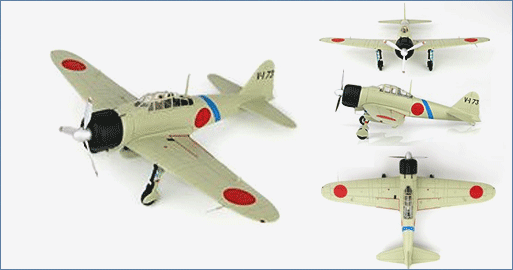Air Power Series>1:48 die-cast display model>Zero>HA8805
Japan A6M2 Zero Type 21 V-173, Rabaul, June to July 1942 "Saburo Sakai"

General Background
The A6M entered service in 1940 and became known as the Zero because of the Japanese
designation of Type 0 Carrier Fighter. The Zero technology was years ahead of any other fighter
and had no problem clearing the skies of opposing aircraft. There were numerous variants of the
Zero including the folding wing A6M2 Model 21 designed for carrier operations. The A6M2 was
the most produced Japanese aircraft of WWII. As the war went on the Model 21 would be the
Zero variant that most Allied pilots would encounter.
The Aircraft
Sakai became a pilot in 1937. In 1938 Sakai flew an A5M Navy Type 96 fighter, scoring one
victory over a DB-3 bomber. In 1940 he was chosen to test the new A6M Zero against the
Chinese and in late 1941 joined the Tainan Air Group on Taiwan. He used A6M2 Zero V-173
while based on Rabaul in June and July 1942. Ordered to shoot down any Allied aircraft, military
or civil Sakai refused to shoot down a C-47 when he saw a woman and a child onboard. Sakai is
credited with 64 victories.
Specifications :
| Role: | Fighter |
| Production Of All Zero Types: | Almost 10, 500 |
| Crew: | 1 Pilot |
| Power plant: | 1 X Nakajima Sakae 12 Producing 925 HP |
| Performance: | Speed - 331 mph (533 km/h) |
| Ceiling - 33,792.5 ft (10,300 m) | |
| Range – 1,044 miles (1,680 km) | |
| Weight: | 3,703.7 lb (1,680 kg) Empty |
| Dimensions: | Wingspan – 39 ft 4.4 in (12 m) |
| Length – 29.72 ft (9.06 m) | |
| Height – 10 ft (3.05 m) | |
| Armament | 2 X 7.7 mm Type 97 Machine Guns On Upper Fuselage Firing Through A Synchronized Propeller |
| 2 X 20 mm Type 99 Cannon Wing-Mounted | |
| 2 X External 132 lb (60 kg) Bombs |

